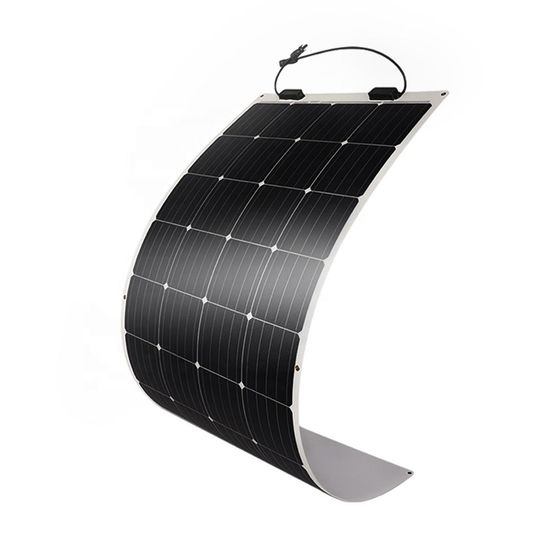
Introduction
Boat enthusiasts and liveaboards are increasingly turning to flexible solar panels as a sustainable energy solution. These lightweight and versatile panels offer unique advantages, especially when dealing with limited space and curved surfaces on boats. In this comprehensive guide, we’ll explore the benefits of flexible solar panels for marine use, installation methods, and how to choose the best system for your vessel.
Click here to view our flexible solar panel product details page
Unique Advantages of Flexible Solar Panels for Boats
Flexible solar panels, also known as thin-film solar panels, are made from lightweight and bendable materials such as amorphous silicon. This design makes them particularly suitable for marine applications, offering several significant advantages:
1.Flexible Installation
The standout feature of flexible solar panels is their ability to bend and conform to curved surfaces. Boats often lack large, flat areas, but flexible panels can be installed on curved decks, canopies, or hulls, maximizing the use of limited space.
2.Lightweight Design
Compared to traditional rigid solar panels, flexible panels are significantly lighter-around 2.5 kg per square meter versus up to 12 kg for rigid panels. This lightweight design reduces the overall load on your boat, helping improve speed and fuel efficiency.
3.Durability and Adaptability
High-quality flexible solar panels are designed specifically for marine environments and offer excellent waterproofing. Many models are rated IP68, meaning they can withstand immersion in water up to 1 meter deep for 72 hours. They also offer superior impact resistance, making them more suitable for the rough conditions at sea than rigid panels.
4.High Efficiency
Modern flexible solar panels deliver impressive conversion efficiencies, with premium products reaching 22.5–25.4%. For example, Blue Marine’s flexible solar panels use high-efficiency monocrystalline cells, achieving conversion rates up to 23%.
Flexible vs. Rigid Solar Panels: A Comparison
To help you make an informed decision, here’s a comparison of the main features of flexible and rigid solar panels:
| Feature | Flexible Solar Panels | Rigid Solar Panels |
|---|---|---|
| Application | Boats, yachts, curved surfaces | Home rooftops, large PV farms |
| Efficiency | Moderate (15–23%) | High (18–23%) |
| Lifespan | 5–15 years | 20–30 years |
| Installation | Simple, lightweight, no drilling | Requires brackets and structure |
| Cost | Lower upfront, ideal for mobile/short-term use | Higher upfront, more economical long-term |
Designing and Installing a Marine Solar System
System Planning
Before designing your boat’s solar system, clarify your power needs:
- Charging batteries only while anchored
- Supplementing an existing generator
- Providing all power needs while at anchor
- Powering all needs both underway and at anchor
Once you know your requirements, calculate your daily power consumption to determine the right panel capacity.
Installation Options
Flexible solar panels offer versatile installation methods:
- Canopy Installation – Mount panels on existing boat canopies
- Deck Installation – Adhere panels directly to curved deck surfaces
- Removable Installation – Easily detach panels for temporary use
Common installation methods include:
- Using structural adhesives for direct bonding
- Using pre-drilled holes and fasteners
Choosing a Controller
For optimal performance, pair your marine solar system with a high-quality controller:
- MPPT Controllers – Extract maximum power from solar panels, especially for systems above 200W
- DuoRacer Series – Can charge two battery banks simultaneously, providing most power to the house battery and trickle charging the starter battery
For unique marine environments, equipping each panel with its own MPPT controller can boost performance by up to 30% compared to traditional PWM controllers.
Cost and Return on Investment
Investment Cost
The cost of a marine solar system depends on the system size and component quality:
- Basic system (200W deck installation): approx. $1,450
- Medium system (300W total): approx. $1,821
- Premium system (400W total): approx. $2,294
Learn more about product prices and specifications-click here to visit our product details page.We offer more affordable prices.
Long-Term Benefits
While the upfront investment may be higher, marine solar systems offer significant long-term advantages:
- Reduced fuel consumption and generator runtime
- Lower noise pollution
- Clean, renewable energy supply
- Increased off-grid capability
- Potential eligibility for up to 30% federal tax credits
Maintenance and Care
To ensure long-term, efficient operation of your flexible solar system:
- Regular Cleaning – Keep panel surfaces free of debris
- Prevent Damage – Avoid scratching the panel surface with sharp objects
- Check Connections – Ensure all electrical connections are secure and corrosion-free
- Controller Maintenance – Regularly check controller functionality
Conclusion
Flexible solar panels are an ideal energy solution for boats-they’re lightweight, adaptable, and efficient, perfectly suited to the unique challenges of marine environments. While their lifespan is shorter than rigid panels, their advantages in limited or irregular spaces are clear.
With proper system planning, high-quality components, and correct installation and maintenance, a flexible solar system can provide reliable renewable energy, reduce your reliance on fuel, and enhance your boating experience.
Whether you’re a weekend sailor or a long-term cruiser, flexible solar panels can provide clean, quiet, and reliable power for your vessel, allowing you to enjoy a freer and more eco-friendly life on the water.
To learn more about flexible solar solutions for boats, or to customize a solar system for your vessel, contact our professional team for a tailored solution.
Click here for personalized solar customization services


















